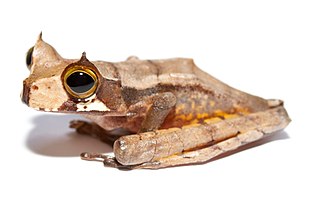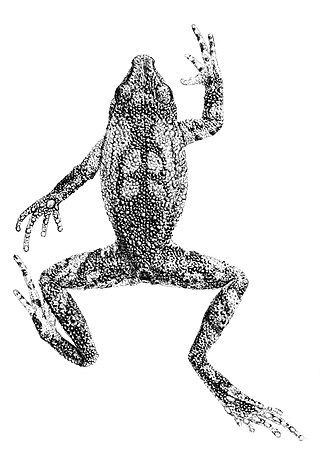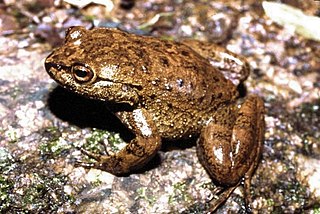
Melanophryniscus is a genus of toads in the family Bufonidae. They are found in northern half of Argentina, southern Bolivia, southern Brazil, Paraguay, and Uruguay. Common name South American redbelly toads has been coined for them.

Suriname toads are members of the frog genus Pipa, within the family Pipidae. They are native to northern South America and extreme southern Central America (Panama). Like other pipids, these frogs are almost exclusively aquatic.

The saddleback toads (Brachycephalus) are a genus of tiny toads and frogs in the family Brachycephalidae in the order Anura, ranging from south Bahia to Santa Catarina in southeastern Brazil. The genus includes two main groups, the often brightly coloured pumpkin toadlets, and the overall brown and more frog-like flea frogs, which once were placed in their own genus Psyllophryne. Some pumpkin toadlets are toxic and their often bright colours are considered aposematic. At about 1 cm (0.4 in) or less in snout–to–vent length, the flea frogs are some of the smallest frogs in the world.

Gastrotheca is a genus of frogs in the family Hemiphractidae. They are found in Central America south of Costa Rica and in South America. Most species occur in the American Cordillera from southern Costa Rica to north-western Argentina. This genus makes up the bulk of marsupial frog diversity; formerly it was placed in the "Leptodactylidae" assemblage.

Euparkerella, sometimes known as Guanabara frogs, is a genus of frogs in the family Strabomantidae. They are endemic to the Atlantic coastal forests in the south-eastern Brazilian states of Espírito Santo and Rio de Janeiro. The name Euparkerella honours H. W. Parker, a herpetologist who named the type species, with the Greek prefix eu meaning true and suffix ella, a diminutive form.

Physalaemus is a large genus of leptodactylid frogs. These frogs, sometimes known as dwarf frogs or foam frogs, are found in South America. It is very similar to Leptodactylus, a close relative, and indeed the recently described Leptodactylus lauramiriamae is in some aspects intermediate between them.

Leptodactylus is a genus of leptodactylid frogs. It includes the species commonly called ditch frogs or white-lipped frogs. It is very similar to Physalaemus, a close relative, and indeed the 2005 described Leptodactylus lauramiriamae is in some aspects intermediate between them. The name means ‘slender finger’, from leptos and the Greek daktylos.

Chiasmocleis is a genus of microhylid frogs. They are found in tropical South America north and east of the Andes. Their common name is humming frogs or silent frogs, the latter referring to the formerly recognized Syncope.

Oreobates is a genus of frogs in the family Strabomantidae. Most species were formerly in the genus Ischnocnema, but were moved to this revalidated genus following a 2006 revision. Its sister taxon is Lynchius.

Dendrophryniscus berthalutzae is a species of toad in the family Bufonidae. It is endemic to southeastern Brazil where it is found in the coastal plain of Santa Catarina and Paraná states.

Amazophrynella bokermanni is a species of toad in the family Bufonidae. It is endemic to Brazil and only known from the region of its type locality, the Amazonas state. Its natural habitats are old-growth forests where it occurs in leaf-litter. The eggs are laid on aerial roots over temporary pools where the tadpoles then develop.

Dendrophryniscus leucomystax is a species of toad in the family Bufonidae. It is endemic to southern and southeastern Brazil and occurs in coastal forests of Rio de Janeiro, São Paulo, and Santa Catarina states. It is a very common species living in secondary and primary forests on leaves near the ground and in bogs. Breeding takes place in rain pools on the ground. It is threatened by habitat loss caused by clear-cutting of forests and large-scale livestock farming.
Melanophryniscus spectabilis is a species of toads in the family Bufonidae. It is known from western Santa Catarina and southern Paraná states, southern Brazil. The specific name spectabilis refers to the showy color pattern of this species.

Dendrophryniscus proboscideus is a species of toad in the family Bufonidae. It is endemic to Southeastern Brazil and known from isolated records in fragments of Atlantic Forest in eastern Bahia and northeastern Minas Gerais states.

Proceratophrys is a genus of frogs in the family Odontophrynidae. They are found in eastern and southern Brazil, northeastern Argentina, and Paraguay, possibly into Bolivia adjacent to the Brazilian border.

Brachycephalus nodoterga, also known as the Serra Cantareira saddleback toad, is a species of frog in the family Brachycephalidae. It is endemic to the eastern São Paulo state of southeastern Brazil, and only known from five locations in Atlantic rainforest at altitudes of 700–900 m (2,300–3,000 ft).

The Brazilian gold frog, also known as Izecksohn's toad or flea-frog, is a very small species of frogs in the family Brachycephalidae. It is endemic to southeastern Brazil and is known from the central part of the state of Rio de Janeiro and from Serra das Torres in extreme southern Espírito Santo.

Amazophrynella is a genus of toads in the family Bufonidae. They are found throughout the Amazon Basin.

Phantasmarana is a genus of frogs in the family Hylodidae. The genus is endemic to the Atlantic Forest of southeastern Brazil.


















